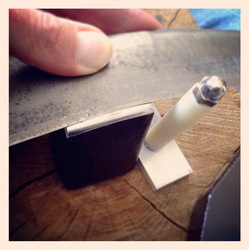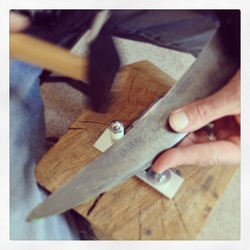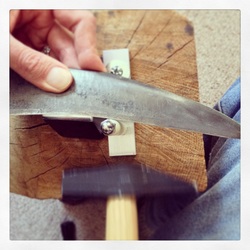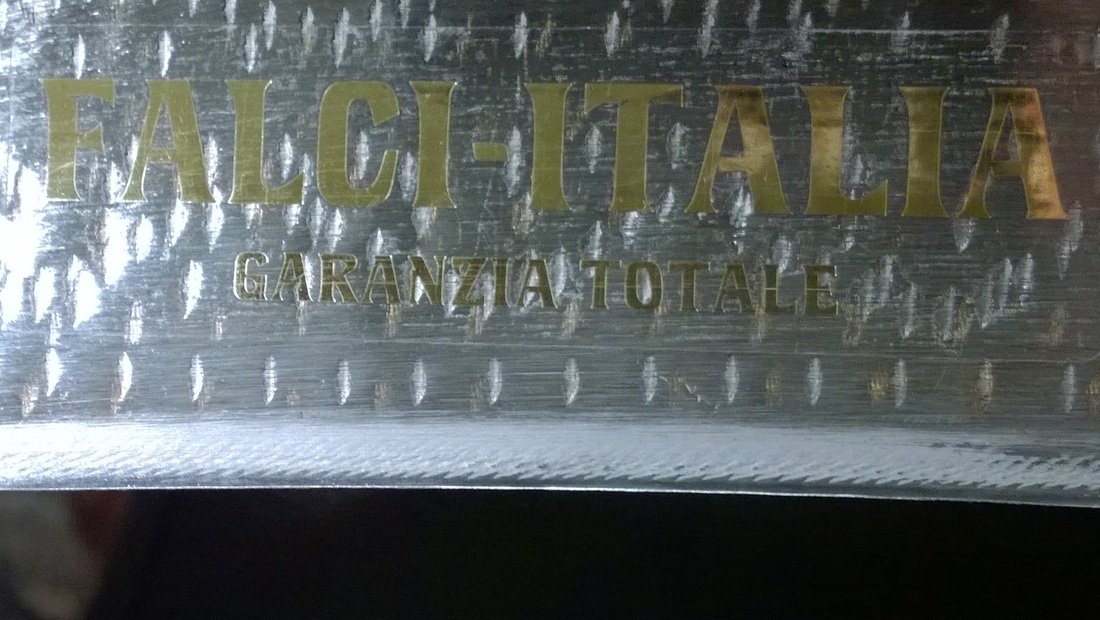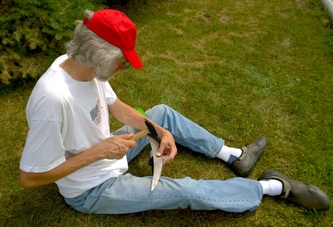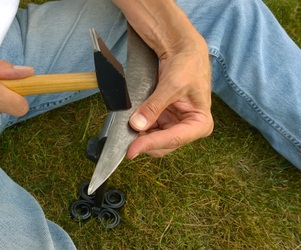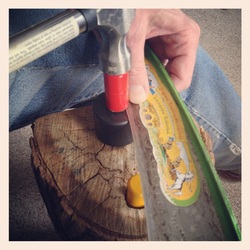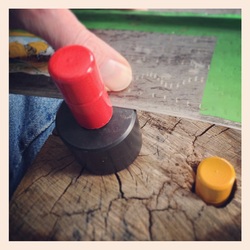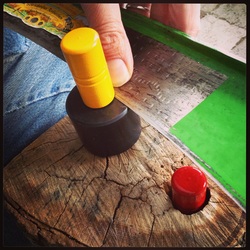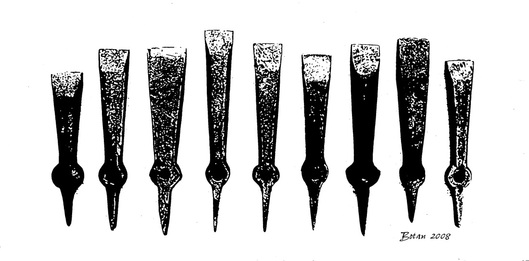Peening Anvils
Picard Narrow Anvil
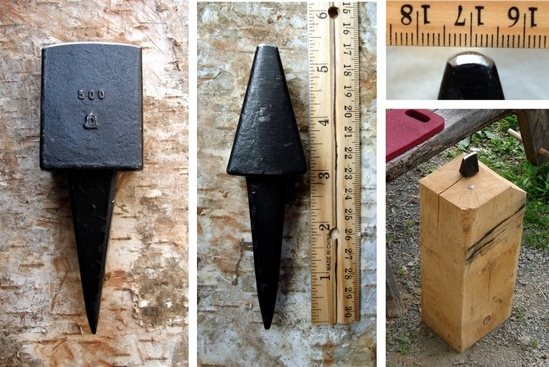
A premium quality, traditional ,"short", narrow anvil, made by the Picard Company of Germany. It weighs 500 grams, has a hardness of 50-58 HRC, and has a medium or normal radius. The tapered spike is for mounting the anvil into a pre-drilled hole in a hardwood stump. The anvil face is polished to a mirror finish. - $45.00
1SR Peening Roll-Guide for Short, Narrow Anvils

A peening guide for the Picard narrow anvil. I had these made at my local machine shop. Made in the USA, with foreign and domestic parts. The guide is screwed down on your peening block, with just one screw. You tighten the screw just firm enough to make the guide stay put when peening, but just loose enough so that you can tap the aluminum bar with your hammer, to quickly adjust it, forwards or backwards, a hair or two, as needed. Tapping on the aluminum won't mar your peening hammer, and the nylon rollers won't dull your edge. The nylon rollers roll so smooth and true, you can't even feel them turning. If the line that the edge makes on the top 1" roller, ever gets too deep, you can unscrew the cap nut, and flip the roller over. If that one wears out, you can move it to the bottom, and bring the fresh one on the bottom, up to the top. This guide will help you peen a more consistent line, and will help ease the strain on your fingers from having to hold the blade so tight. For more info see my blog. -$32.50
The manual for the 1SR Roll-Guide is available as a document on my Peening workshop page.
Peening Instruction Manuals

Peening and "Austrian" (tensioned) Scythe Blade on a Narrow Anvil
Now available online on my Peening workshop page.
Now available online on my Peening workshop page.
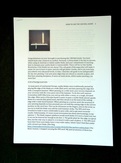
I ordered the narrow anvil and hammer set from you and would like to tell you that I am so happy I did. Before I was trying to sharpen my blades with a peening jig and I never could get them sharp again - I still had to mow and it was a bit of a slog. I finally got better at honing after watching videos of Alpine folks demonstrate (I have one of those more cigar shaped stones and the instructions I had before were for the different style of honing) but peening with the jig never worked.
After reading all the instructions and watching a video I went to work on last year's blade yesterday and low and behold, it worked! I am so glad that after 3 mowing seasons I have finally figured it out! Thank you for the very thorough education!
Now I am not loving my whetstones, still, so I would like to order a Bergamo, to use now and a Doppelbock (ooh, my favorite beer, the Andechser!) for when I am really good at this.
I have two acres of Californian weeds and grasses to mow every year - I am getting a lot of practice...
Thank you!
Stephanie S.
Picard Wide Anvil
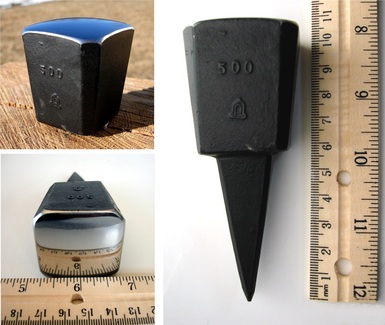
A premium wide anvil, made by the Picard Company of Germany. Beautifully shaped. Exceptionally hard. 500g. For "Old School" Austrian-style peening, where the blade is placed right-side-up on the wide anvil, and the edge is peened from the top with a cross-peen hammer. Wide anvils are also occasionally needed by narrow anvil owners when they need to repair a small crack in their blade. See page 158 of The Scythe Book. To repair small cracks in your blade, you need a wide anvil like this, and a true scythe hammer with a cross-peen side. - $45.00
Austrian Wide Anvil
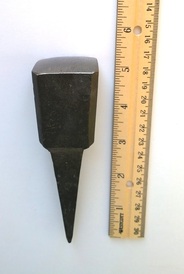
A heavy duty wide anvil. 588g. It has a 3 inch long spike. More domed than the Picard wide anvil above. The sloped sides at the base, don't give you a ledge to pry the anvil back out of the stump with. Once it's in the peening stump, it's hard to get back out. Made in Austria. Unpoilished - $30 out-of-stock
Rinaldi 705 Tall Anvil
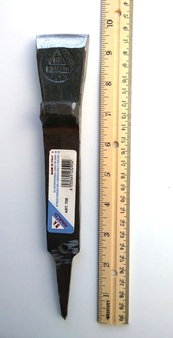
A 7 1/4 inch tall, narrow anvil, with a 2 inch spike. 766g.
Excellent hardness. Even harder than the Picard anvils! Tall anvils are nicest when used on a stump or log big enough for you to sit on as well. The height extends the anvil face up above the top of your thighs. You can then easily support either end of the blade with the tops of your thighs, and the weight of your body helps keep the whole block still. But they can also be used on a smaller wooden stump separate from your seat, like a short anvil. The advantage is you can use a shorter log, and you don't have to notch out one side of the log to make room for the tang of the blade. - $45 out-of-stock
Excellent hardness. Even harder than the Picard anvils! Tall anvils are nicest when used on a stump or log big enough for you to sit on as well. The height extends the anvil face up above the top of your thighs. You can then easily support either end of the blade with the tops of your thighs, and the weight of your body helps keep the whole block still. But they can also be used on a smaller wooden stump separate from your seat, like a short anvil. The advantage is you can use a shorter log, and you don't have to notch out one side of the log to make room for the tang of the blade. - $45 out-of-stock
Field Anvils
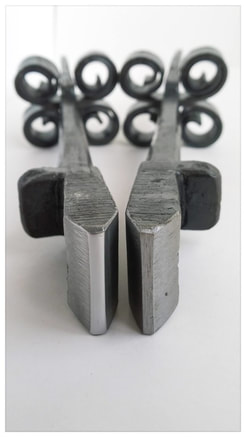 Rinaldi 701 Field Anvil
Rinaldi 701 Field Anvil
Rinaldi 701 Field Anvil. Italy. Length: 40cm (15.5 inches), Weight: 1263g ( 2# 13oz.) - $55
Traditionally field anvils were carried to remote fields, when mowing all day. They were stuck in the ground, during the noon lunch break, and the blades were touched up and peened for the afternoon mowing session. You sit on the ground (it's more comfortable on a slope) with your legs stretched out. You support the blade with one leg or the other, as you are peening. Some scythers prefer peening with a field anvil all the the time. There is no rebound whatsoever with a field anvil stuck in the dirt. The dirt absorbs too much of the blow, so some of the subtler hammering techniques are not possible, and peening may take a little longer. But it beats lugging a peening stump with you to a remote meadow. This anvil has a small platform, so that you can hit it with the side of your hammer to drive the spike into the ground. Don't drive the anvil into the ground by hammering the anvil face with a hammer. You see a lot of antique field anvils (without such ledges), with mushroomed faces on top, because somebody hammered them into the ground, by hammering the anvil face with their peening hammer! Don't do that! Use the ledge, and the side of your hammer. However, I found that It was much easier to drive into the ground by pounding the anvil on top with my white oak "persuader", which I shaved with a drawknife from a pice of split firewood. The ledge can also be used as a finger rest. Instead of a long tapered square spike, as most field anvils that I have seen, this Rinaldi field anvil has a wide, weed-knife like blade, which is easy to drive into the ground, yet gives great directional stability for the drawing hammer strike. The anvil face is unfinished. It is flat with sharp edges. (Not ready for peening!), but I will shape and polish it for you. - $60 out-of-stock
Peening Jigs
The New Schroeckenfux Schlagdengelapparat, a.k.a. "Peening Jig"
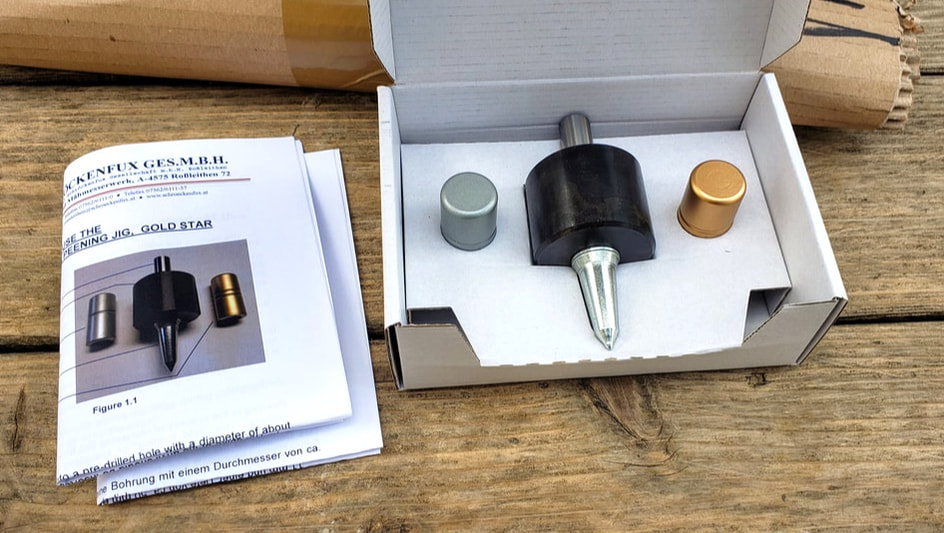
Fux Silver and Gold Peening Jig
New! I haven't recommended peening jigs before, because they ruin the nice triple-peened edges. This peening jig has a new and improved cap design, that maintains the structural integrity of the peened edge, instead of creating that awful, huge, drop-off ledge some peening jigs out there make. The ledge created by ordinary peening jigs impede penetration when you are mowing larger stemmed vegetation like weeds and big-stemmed grasses, like reed canary grass. This one makes two mini-steps, that blend together to smooth out the transition between the caps. This also makes for an easier edge to peen out, if you ever want to move up to freehand peening. The caps fit exactly, and are well greased, which has the interesting effect of creating an air-lock. The air trapped inside at the top of the cap, gets compressed with each hammer strike, and instantly rebounds after the strike. The decompressing air lifts the cap back up. This makes it very easy to steadily guide the blade along the post. It's the first time I've ever enjoyed using a peening jig.
If freehand peening is too intimidating for you, or because you did "research" on the web, or you have no real experience with using a hammer other than hanging pictures, then this is the peening jig for you. A 16oz hammer is recommended. It can be an ordinary carpenter hammer. - $115
If freehand peening is too intimidating for you, or because you did "research" on the web, or you have no real experience with using a hammer other than hanging pictures, then this is the peening jig for you. A 16oz hammer is recommended. It can be an ordinary carpenter hammer. - $115
Scythe Hammers
My specialty scythe hammers now have their own page.
